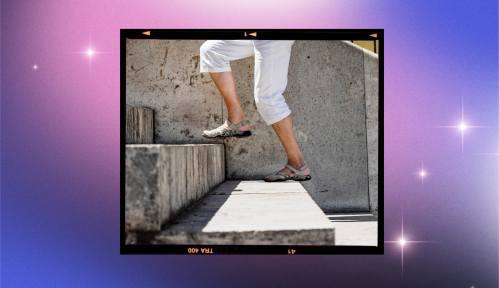Quick Question: If I Have a Headache, Will Working Out Make Me Feel Better or Worse?
When it comes to working out with a headache, doctors weigh in on if exercise will help your headache go away or make it worse.

Picture this: It’s a beautiful Saturday morning and on your calendar is a workout you’ve been itching to knock out. But come your 7 a.m. wakeup call, you have a nagging headache that you just can’t kick.
Experts in This Article
staff neurologist for the Headache and Facial Pain Center in the Center for Neurological Restoration at the Cleveland Clinic Neurological Institute
physician and co-founder of Midwest Anesthesia and Pain Specialists
It begs the question: Is it safe to push through your workout as planned, even with a headache, or should you skip it?
“Headaches don’t have any one-size-fits-all approach,” says Thomas Pontinen, MD, physician and co-founder of Midwest Anesthesia and Pain Specialists. “Doctors and researchers don’t fully understand headaches, which is why it’s hard to give definite advice. What works for one person will not always work for another.”
However, you can use clues about the underlying causes of your headache and your own personal knowledge of how well your body responds to certain stimuli like exercise to determine if you can move forward with your workout. In some cases, it’s best to skip it, but getting moving can actually help your headache in other situations.
“Having a headache doesn’t necessarily mean you need to skip your workout,” Dr. Pontinen says. “For certain situations, such as when someone is suffering from a tension headache or even certain migraines, deciding to get up and move around can be helpful.”
In general, staying active can also help you prevent headaches in the first place—exercise helps your body regulate many of its core systems, Dr. Pontinen adds.
The different types of headaches—and which ones you can work out with
It’s not always easy to identify the type of headache or its cause, but certain symptoms may clue you in on whether or not you should work out.
“Some variables like the type, location, and duration of pain can help determine what’s going on,” Dr. Pontinen says.
If you experience headaches chronically, you might find it helpful to track certain factors—say, dehydration, hunger, or fatigue —to identify which ones trigger your headaches.
Here’s what to know about the different types of headaches and whether you should do your scheduled workout, scale back, or skip it altogether. When in doubt, always speak to your doctor for insight on your unique situation.
“For certain situations, such as when someone is suffering from a tension headache or even certain migraines, deciding to get up and move around can be helpful.” —Thomas Pontinen, MD
1. Tension headache
These headaches feel like a dull ache that spans across the forehead and wraps around the head—think a band tightening around your head. Sometimes, they can also involve the neck.
Exercise can actually help soothe these headaches, says MaryAnn Mays, MD, staff neurologist for the Headache and Facial Pain Center in the Center for Neurological Restoration at the Cleveland Clinic Neurological Institute.
Tension headaches are caused by your neck and scalp muscles tensing up or contracting, per the National Library of Medicine. A common culprit is working at your computer or staying in any other stationary position for too long.
“You might want to start with some stretches of the neck and shoulder and then advance to yoga, Pilates, and a cardiovascular workout,” Dr. Mays says. “Doing exercise consistently can also prevent tension-type headaches.”
2. Migraine
This is a tricky one: Migraines often come with symptoms like nausea, sensitivity to light, and sound—but they’re not well understood and vary in terms of how they present in different people.
“Some who suffer from chronic migraines would never consider working out during an episode, while others might find that working out helps alleviate some of the pain,” Dr. Pontinen says. ”I think if you’re having a migraine and nothing’s helping, trying a mild workout might be worth a shot.”
In this case, starting slowly and working up to an acceptable intensity is key.
“I have heard a few patients state that if they start slow and work their way up in intensity, it can abort a migraine,” Dr. Mays says.
Light aerobic exercise like yoga may also prevent your migraine in the first place. A small 2014 study in the International Journal of Yoga1 found that migraine frequency was reduced even more in a group that practiced yoga and took conventional medicine, compared to a group that only took the meds.
Similar results were seen in a 2015 study published in Advanced Biomedical Research2, in which female patients with migraines were randomly divided into a medication group and a yoga plus medication group. Those who received 12 weeks of yoga training alone had a significant reduction in the impact of headache on their lives, headache severity, and headache frequency, while the changes in the medication-only group weren’t significant.
Meanwhile, a 2019 study in The Journal of Headache and Pain3 found that aerobic exercise can decrease the number of migraine days people experience.
However, pay close attention to your symptoms. Some people may find that activity worsens the migraine and the best cure is lying down in a dark room. Go slow and see if your migraine responds as you work through your exercise.
3. Dehydration headache
This may show up as either a migraine or tension-type headache. Dehydration headaches usually come with symptoms like dry mouth, extreme thirst, dizziness, increased heart rate, reduced blood pressure, fatigue, muscle cramps, dark urine, and fewer bathroom trips.
“Becoming dehydrated has been linked to provoking migraine and worsening migraine symptoms,” Dr. Mays says. “You can often do a workout, but it’s crucial to hydrate before, during, and after exercise.”
In other words, if you suspect a lack of fluids is causing your pain, don’t dive right into a workout and hope for the best. Up your fluids first and take it easy when you do start working out.
“For a dehydration headache, I would avoid any activity until you’ve rehydrated and given your body time to recover,” Dr. Pontinen says. “Dehydration can be dangerously taxing on the body, so I’d only do very light exercise in the 24 hours following headache-inducing dehydration.”
4. Fatigue headache
Like a dehydration headache, a fatigue headache can present as a migraine or tension-type headache.
“This can occur due to lack of sleep or physical exhaustion,” Dr. Mays says. “You may be particularly at-risk during times of stress.”
Undiagnosed sleep apnea or chronic insomnia may contribute to this type of headache, so addressing sleep hygiene can be an important first step. If you’re having trouble sleeping at night, exercising during the day may help you sleep better by reducing stress and improving mood.
In other words, you may find exercising regularly actually helps if you are prone to fatigue headaches.
“Being physically inactive may put you at greater risk for daily headaches and increased frequency of migraine, so even a small amount of activity each day can help with these fatigue headaches,” Dr. Mays says. “But it’s crucial to listen to your body.”
5. Low blood sugar headache
If you have a headache that you suspect is caused by low blood sugar, it may be best to skip your workout. You might have a low blood sugar headache if you also feel dizzy, shaky, anxious, sweaty, or have difficulty concentrating.
“If you’re someone who struggles with blood sugar and blood sugar headaches, you should be extra cautious, because working out with low blood sugar can be dangerous,” Dr. Pontinen says. “The brain is very sensitive to fluctuations in blood sugar, since the brain and body use glucose for energy.”
In general, make sure you eat a small snack containing simple carbs (say, a banana with honey or apple slices with almond butter) before working out to prevent these types of headaches. And of course, always try to fit balanced meals into your diet.
“Generally speaking, a healthy human body will tell you what it needs, so just be conscious and pay attention to how you feel.” —Thomas Pontinen, MD
Tips for exercising with a headache
If you suspect it’s okay to move forward with your workout based on the type of headache you have, here are important tips to follow as you exercise.
1. Go slow
It may be difficult to tell if exercising will help or exacerbate your headache until you’re actually working out, so ease into it and listen to your body.
“Start your workout at a slower pace to see how your body responds, and include warmups and cooldowns,” Dr. Mays says. In other words, this isn’t the time to try a new 60-minute trail run or exercise at an altitude you’re not used to.
Of course, stop exercising if your headache worsens or you have other symptoms like a faint feeling or a heart rate that doesn’t recover when you slow down.
“When in doubt, keep it limited to light cardio or something like yoga,” Dr. Pontinen says. “Generally speaking, a healthy human body will tell you what it needs, so just be conscious and pay attention to how you feel.”
2. Stay hydrated
It’s not just about drinking H20 before your workout to prevent a headache. You also need to stay hydrated throughout and after your workout.
“Take smaller sips throughout your workout and avoid drinking too much water too quickly to avoid an upset stomach,” Dr. Mays says. “If you’re overheated, find a cool place to rest or put a cold compress on your head or wrist.”
If you think you have a dehydration headache, drink 16 ounces of water about two hours before intense exercise. Sports drinks aren’t necessary for most non-athletes, adds Dr. Mays, because water and food can provide the same electrolytes and nutrients.
However, you may find sports drinks helpful if you’re exercising for more than an hour, performing intense physical activity, exercising outdoors on a hot and humid day, sweating a lot, or still experiencing symptoms of dehydration despite replenishing with water.
Many sports drinks contain electrolytes, which you tend to lose when you sweat a lot or are dehydrated. These are electronically charged minerals that play an important role in many of your body’s processes, including your heart and muscle function, per the Cleveland Clinic. You can also get them naturally from foods like fruits, leafy greens, dairy products, nuts and seeds, beans, or pickle juice.
“If you’re experiencing a headache due to dehydration, your first step should be to hydrate with electrolytes and wait a while before doing any kind of exercise,” Dr. Pontinen says. “When you’re dehydrated, you can’t just drink something and get going. The body will need time to catch up on the lack of hydration, because it takes time to absorb water and hydrate tissues.”
If you’re an older adult, you need to be especially careful because you’re at greater risk for dehydration and may not receive as many clues from your body that you’re dehydrated. No matter what your age, take precautions like avoiding exercise during the hottest part of the day.
3. Opt for gentle exercises
Certain types of workouts may trigger or worsen a headache, while others can soothe it.
“Overhead presses commonly trigger headaches, as those individual neck muscles are often weak,” Dr. Mays says. “If this happens, focus on core strengthening first. Yoga, Pilates, qigong, and tai chi may be helpful in managing headaches in those with neck pain and decreased neck mobility.”
Light cardio also offers the benefits of endorphin release, tension release, and increased circulation (without as much risk of over-exertion as more intense physical exercises like resistance training), Dr. Pontinen adds. That boosted circulation and endorphins release can directly help relieve tension headaches and some migraines.
“If you have a headache and want to try working out, start with some light cardio and see how you feel,” Dr. Pontinen says. “If you feel better, try some light resistance training and see how things go. If you feel good, consider a normal workout, but avoid pushing yourself too hard.”
If you find that exercise always triggers a headache, talk to a physician to explore potential underlying causes. Your doctor may conduct tests like imaging of the brain or spine to rule out structural causes. If no underlying condition is found, you may be referred to a physical therapist to learn proper techniques for exercising.
“A physical therapist may identify muscles you didn’t know were weak and prescribe specific exercises to address weak muscles,” Dr. Mays says, who recommends incorporating techniques like deep breathing or gentle stretching to help alleviate the start of a headache during or after a workout. Massaging your neck or temples and using a topical cooling spray or gel with menthol can also help.
The bottom line
It may be safe and even beneficial to workout when you have a headache, particularly if it’s a tension-type headache or a migraine (in certain cases). If you have a dehydration or low blood sugar headache, hold off on the workout until you’ve had the chance to address the underlying issue. And if you find yourself prone to fatigue headaches, see if light, regular exercise helps to improve the issue over time.
Headaches can be tricky to decipher and are unique based on the individual, so it’s important to take it slow and listen to your body in every case. If something doesn’t feel right or your headache gets worse with activity, stop right away and talk to your doctor.
Kisan R, Sujan M, Adoor M, Rao R, Nalini A, Kutty BM, Chindanda Murthy B, Raju T, Sathyaprabha T. Effect of Yoga on migraine: A comprehensive study using clinical profile and cardiac autonomic functions. Int J Yoga. 2014 Jul;7(2):126-32. doi: 10.4103/0973-6131.133891. PMID: 25035622; PMCID: PMC4097897.
↩︎Boroujeni MZ, Marandi SM, Esfarjani F, Sattar M, Shaygannejad V, Javanmard SH. Yoga intervention on blood NO in female migraineurs. Adv Biomed Res. 2015 Dec 31;4:259. doi: 10.4103/2277-9175.172995. PMID: 26918241; PMCID: PMC4746941.
↩︎Lemmens, J., De Pauw, J., Van Soom, T. et al. The effect of aerobic exercise on the number of migraine days, duration and pain intensity in migraine: a systematic literature review and meta-analysis. J Headache Pain 20, 16 (2019). https://doi.org/10.1186/s10194-019-0961-8
↩︎
Sign Up for Our Daily Newsletter
Get all the latest in wellness, trends, food, fitness, beauty, and more delivered right to your inbox.
Got it, you've been added to our email list.










